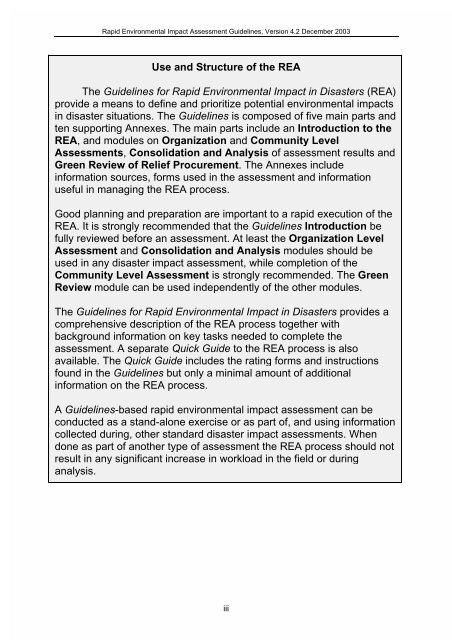Guidelines for Rapid Environmental Impact Assessment in Disasters
Guidelines for Rapid Environmental Impact Assessment in Disasters
Guidelines for Rapid Environmental Impact Assessment in Disasters
You also want an ePaper? Increase the reach of your titles
YUMPU automatically turns print PDFs into web optimized ePapers that Google loves.
<strong>Rapid</strong> <strong>Environmental</strong> <strong>Impact</strong> <strong>Assessment</strong> <strong>Guidel<strong>in</strong>es</strong>, Version 4.2 December 2003<br />
Use and Structure of the REA<br />
The <strong>Guidel<strong>in</strong>es</strong> <strong>for</strong> <strong>Rapid</strong> <strong>Environmental</strong> <strong>Impact</strong> <strong>in</strong> <strong>Disasters</strong> (REA)<br />
provide a means to def<strong>in</strong>e and prioritize potential environmental impacts<br />
<strong>in</strong> disaster situations. The <strong>Guidel<strong>in</strong>es</strong> is composed of five ma<strong>in</strong> parts and<br />
ten support<strong>in</strong>g Annexes. The ma<strong>in</strong> parts <strong>in</strong>clude an Introduction to the<br />
REA, and modules on Organization and Community Level<br />
<strong>Assessment</strong>s, Consolidation and Analysis of assessment results and<br />
Green Review of Relief Procurement. The Annexes <strong>in</strong>clude<br />
<strong>in</strong><strong>for</strong>mation sources, <strong>for</strong>ms used <strong>in</strong> the assessment and <strong>in</strong><strong>for</strong>mation<br />
useful <strong>in</strong> manag<strong>in</strong>g the REA process.<br />
Good plann<strong>in</strong>g and preparation are important to a rapid execution of the<br />
REA. It is strongly recommended that the <strong>Guidel<strong>in</strong>es</strong> Introduction be<br />
fully reviewed be<strong>for</strong>e an assessment. At least the Organization Level<br />
<strong>Assessment</strong> and Consolidation and Analysis modules should be<br />
used <strong>in</strong> any disaster impact assessment, while completion of the<br />
Community Level <strong>Assessment</strong> is strongly recommended. The Green<br />
Review module can be used <strong>in</strong>dependently of the other modules.<br />
The <strong>Guidel<strong>in</strong>es</strong> <strong>for</strong> <strong>Rapid</strong> <strong>Environmental</strong> <strong>Impact</strong> <strong>in</strong> <strong>Disasters</strong> provides a<br />
comprehensive description of the REA process together with<br />
background <strong>in</strong><strong>for</strong>mation on key tasks needed to complete the<br />
assessment. A separate Quick Guide to the REA process is also<br />
available. The Quick Guide <strong>in</strong>cludes the rat<strong>in</strong>g <strong>for</strong>ms and <strong>in</strong>structions<br />
found <strong>in</strong> the <strong>Guidel<strong>in</strong>es</strong> but only a m<strong>in</strong>imal amount of additional<br />
<strong>in</strong><strong>for</strong>mation on the REA process.<br />
A <strong>Guidel<strong>in</strong>es</strong>-based rapid environmental impact assessment can be<br />
conducted as a stand-alone exercise or as part of, and us<strong>in</strong>g <strong>in</strong><strong>for</strong>mation<br />
collected dur<strong>in</strong>g, other standard disaster impact assessments. When<br />
done as part of another type of assessment the REA process should not<br />
result <strong>in</strong> any significant <strong>in</strong>crease <strong>in</strong> workload <strong>in</strong> the field or dur<strong>in</strong>g<br />
analysis.<br />
iii
















